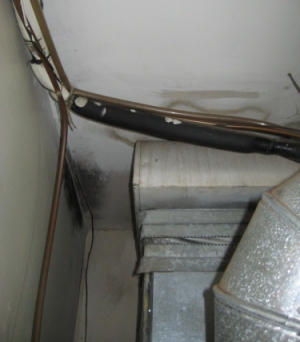How to Choose a Mold Remediation Company
 Undetected water damage in a home or office can lead to serious mold problems, which can in turn cause serious health issues. Sometimes mold remediation is not the best solution when the damage is systemic or the health of the occupants is severely compromised. (See our article When Remediation Fails.)
Undetected water damage in a home or office can lead to serious mold problems, which can in turn cause serious health issues. Sometimes mold remediation is not the best solution when the damage is systemic or the health of the occupants is severely compromised. (See our article When Remediation Fails.)
In other situations, the water damage is isolated enough to warrant remediation. But tackling the mold issue yourself can often make matters worse, as opening up a wall without proper containment can exacerbate the problem.
Finding a qualified remediator who understands the potential hazards of improper remediation can be difficult. Don't be afraid to ask the following questions before hiring a mold remediation company.
Mold Remediation Advice
Once you've identified a mold problem, what should your next step be? The following information is excerpted from an article by leading natural physician Dr. Joseph Mercola. In this article, he refers to his interview with renowned toxicologist, the late Dr. Jack Thrasher.
As soon as you've identified the problem, you have to stop the water intrusion and remediate the problem at its source.
How to Clean Up Minor Surface Mold
If you have just a small area of surface mold, you probably don't have to call in an expert. However, only attempt to clean it if it's limited to the surface of a small area. You cannot "clean" deep-rooted mold. Dr. Thrasher has one word for those of you who have bought into the home-remedy advice to "kill off mold" with ammonia or bleach: Don't.
When Remediation Fails
The book of Leviticus makes it clear that if mold is still present after remediation, the home is unsafe. This is a radical approach to mold, one shared by leading toxicologist, the late Dr. Jack Thrasher. Dr. Thrasher, author of the article The Biocontaminants and Complexity of Damp Indoor Spaces: More Than What Meets the Eyes, said it is best to flee a home rather than remediate when serious health issues exist and when a serious infestation is involved. According to Dr. Thrasher:
I have always been skeptical regarding the successful remediation of homes and buildings contaminated with fungi and bacteria from water intrusion. Buildings and homes are complicated structures. The spores of both bacteria and fungi, as well as their by-products (fine particles less than one micron to those equal or greater than the mold spores), are present in dust. The dust can be found in all nooks and crannies of a building, e.g. refrigerator insulation and coils, areas not normally dusted, even in carpeting that has been vacuumed, under carpeting, and in wall cavities. Finally, little attention is paid to the contaminants in buildings that result from Gram negative and positive bacteria.

